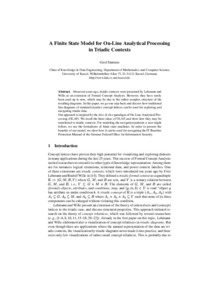A finite state model for on-line analytical processing in triadic contexts
| dc.date.accessioned | 2009-04-08T13:25:24Z | |
| dc.date.available | 2009-04-08T13:25:24Z | |
| dc.date.issued | 2005 | |
| dc.identifier.uri | urn:nbn:de:hebis:34-2009040826878 | |
| dc.identifier.uri | http://hdl.handle.net/123456789/2009040826878 | |
| dc.format.extent | 254926 bytes | |
| dc.format.mimetype | application/pdf | |
| dc.language.iso | eng | |
| dc.rights | Urheberrechtlich geschützt | |
| dc.rights.uri | https://rightsstatements.org/page/InC/1.0/ | |
| dc.subject.ddc | 004 | |
| dc.title | A finite state model for on-line analytical processing in triadic contexts | eng |
| dc.type | Preprint | |
| dcterms.abstract | About ten years ago, triadic contexts were presented by Lehmann and Wille as an extension of Formal Concept Analysis. However, they have rarely been used up to now, which may be due to the rather complex structure of the resulting diagrams. In this paper, we go one step back and discuss how traditional line diagrams of standard (dyadic) concept lattices can be used for exploring and navigating triadic data. Our approach is inspired by the slice & dice paradigm of On-Line-Analytical Processing (OLAP). We recall the basic ideas of OLAP, and show how they may be transferred to triadic contexts. For modeling the navigation patterns a user might follow, we use the formalisms of finite state machines. In order to present the benefits of our model, we show how it can be used for navigating the IT Baseline Protection Manual of the German Federal Office for Information Security. | eng |
| dcterms.accessRights | open access | |
| dcterms.creator | Stumme, Gerd | |
| dc.description.everything | Auch erschienen in: Ganter, Bernhard u.a. (Hrsg.): Formal concept analysis. (Lecture notes in computer science ; 3403) Berlin u.a. : Springer, 2005. S. 315-328. ISBN 3-540-24525-1 (The original publication is available at www.springerlink.com) | ger |
| dc.subject.swd | Formale Begriffsanalyse | ger |
Dateien zu dieser Ressource
Das Dokument erscheint in:
-
Publikationen [55]

